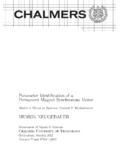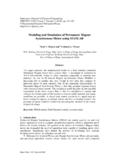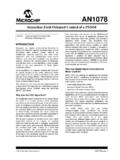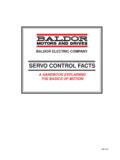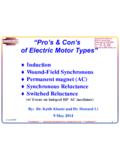Transcription of A Fault Tolerant Machine Drive Based on Permanent Magnet ...
1 Abstract A Fault Tolerant Machine Drive Based on Permanent Magnet (PM) assisted synchronous reluctance Machine is proposed and investigated for safety critical applications. In order to achieve enhanced Fault Tolerant capability, the risk of the Permanent Magnet field that cannot be turned off under Fault conditions is minimized without compromising the torque density and efficiency. This is achieved by employing a synchronous reluctance rotor topology with embedded Permanent magnets. Three independent 3-phase windings are adopted and a segregated winding configuration is devised to ensure non-overlapping in the three 3-phase winding sets. Each 3-phase winding set is driven by a standard 3-phase inverter, which facilitates fast integration and cost reduction.
2 The performance under various Fault conditions has been evaluated by FE simulations. The results show that the proposed Machine Drive exhibits high performance as well as excellent Fault Tolerant capability under various faults, including open circuit, terminal short circuit, and inter-turn short circuit, etc. Index Terms Fault Tolerant Machine , Permanent Magnet assisted synchronous reluctance Machine , multi-phase Machine , non-overlapped winding configuration. I. INTRODUCTION AULT Tolerant Machine and drives are capable of providing uninterrupted operation during Fault conditions, therefore being attractive in safety critical applications, such as aerospace and electric traction[1, 2]. While electrical drives possess enhanced functionality, adaptability and controllability compared with the conventional mechanical, hydraulic, and pneumatic systems [3], relative low reliability of electric Drive systems presents a restriction for their wide applications since an unexpected Fault would cause serious consequences or economic losses.
3 Thus, Fault tolerance is an essential requirement for electrical drives to attain high availability. To this end, various Fault Tolerant Machine topologies and techniques have been investigated in literatures. The most straightforward approach is to adopt two or more Machine - Drive modules either in series or in parallel [4, 5]. However, use of multiple Machine drives for redundant This work is supported in part by the UK Engineering and Physical Science Research Council (EPSRC) under Grant Ref no. EP/K034987/1 Bo Wang, J. Wang and A. Griffo are with the Department of Electronic and Electrical Engineering, The University of Sheffield, Mappin Street, Sheffield S1 3JD, United Kingdom (e-mail: Z.)
4 Sun, and E. Chong are with Rolls-Royce plc, PO Box 31, Derby, DE24 8BJ, United Kingdom operation requires large space and necessitates additional accessories to guarantee its operation in healthy and Fault conditions, resulting in low power density and bulky size. Alternatively, Fault tolerance may be achieved on a single 3-phase Machine Drive by employing a neutral connection to the midpoint of the DC link or to a fourth inverter leg [6]. Zero sequence current is utilized to generate the equivalent rotating magneto-motive force (MMF) if one phase is open-circuited. The neutral connection and zero sequence current can be eliminated by employing more than three phases in a single Machine [7]. Depending on the number of phases, a multi-phase (number of phases > 3) Machine may be capable of continuous operation when more than one phase has failed.
5 The concept has been realized in both induction machines and Permanent Magnet machines [8-12]. Additionally, various control algorithms were proposed to achieve the maximum available torque, or minimum torque ripple [13-15] under Fault conditions. It is worth noting that the majority of the above measures address the open circuit failure only. In order to accommodate short circuit failure in the power electronic switches or phase windings, advanced Fault Tolerant drives were developed. Owing to its rugged, Magnet -free rotor structure and concentrated windings, switched reluctance Machine (SRM) is inherently Fault Tolerant [16, 17]. Each phase winding can be magnetically, thermally and electrically isolated. Due to low mutual coupling between phases, the short circuit current as a result of inverter failure or an inter-turn Fault can be restricted in a safe region [18].
6 However, an SRM exhibits high torque ripple, undesirable noise and vibration, and poor torque density/efficiency. In [19] a single layer fractional slot concentrated winding (FSCW) Permanent Machine is developed that facilitates electrical, magnetic, thermal, and physical isolations between phases. The slot opening is specially designed to obtain per-unit inductance. As a result, the terminal short circuit current is limited under a rated value. This methodology has also been extended to switched flux Permanent machines with similar winding configuration [20]. However, due to the concentrated windings, very little reluctance torque can be exploited in this type of Machine topology. The output torque of a FSCW PM Machine relies on the PM field and, consequently, increase in torque capability leads to great flux linkage.
7 The presence of strong PM field may pose a safety hazard to the Machine as it cannot be turned off in the event of a Fault [21]. In case of Bo Wang, Jiabin Wang, Antonio Griffo, Zhigang Sun, and Ellis Chong A Fault Tolerant Machine Drive Based on Permanent Magnet assisted synchronous reluctance Machine F978-1-5090-0737-0/16/$ 2016 IEEE an inverter failure, the back electromotive force (emf) may be higher than the DC link voltage at high speeds and uncontrolled rectification via the diodes may occur. Excessive regenerative power which flows to the dc link capacitor may cause catastrophic failure to the Drive system. Significant braking torque may also be imposed on the rotor causing huge stress to the mechanical system or sudden reduction in speed which may induce accidents in traction drives.
8 Thus, the maximum back emf should be limited [22]. However, this is in conflict with the torque production. On the other hand, if the FSCW Machine is required to operate in a wide constant power range, the VA rating of the inverter increases linearly with the speed, which in turn increases the overall size and cost of the Drive . Further, the use of concentric windings also gives rise to sub- and high-order magneto-motive force (MMF) space harmonics which produce extra rotor loss. Hence, the magnets need to be segmented axially or circumferentially to avoid excessive rotor temperature. Manage and control of inter-turn short-circuit current in a FSCW PM Machine are also very challenging [23, 24] because its magnitude may still be many times greater than a thermally sustainable value even after a terminal short circuit as the remedial action.
9 Recently, PM assisted synchronous reluctance Machine (PMA SynRM) has gained increasing interests as a viable candidate for electric traction due to reduced magnets usage, extended field weakening range and comparable performance with conventional PM machines[25, 26]. These unique characteristics are mainly attributed to the combined torque production mechanism, both the PM torque and reluctance torque. The reluctance torque enables use of less Magnet material and results in low back emf which improves the Machine s Fault Tolerant capability. The main disadvantage of this Machine is that it usually employs distributed windings which are beneficial for exploiting reluctance torque. The use of the overlapped windings yields strong inter-phase coupling.
10 And the coils of different phases may overlap in slots and in the end winding regions. Consequently, a Fault in one phase could easily propagate to or affect other phases. For a conventional 3-phase Machine Drive , a single failure in any part of the Drive will lead to a complete failure [27-29]. This paper aims to develop a new Fault Tolerant Machine Drive Based on PMA SynRM topology. By employing appropriate winding configurations, the Machine can be optimized to have high torque density while exhibiting fail-safe and Fault Tolerant characteristics. Detailed analysis is performed to examine its Fault Tolerant capabilities for various faults, such as open circuit, short circuit, and inter-turn short circuit. II. Fault Tolerant WINDING CONFIGURATION FOR PMA SYNRM Conventional 3-phase windings of a PMA SynRM are usually distributed as shown in Fig.
